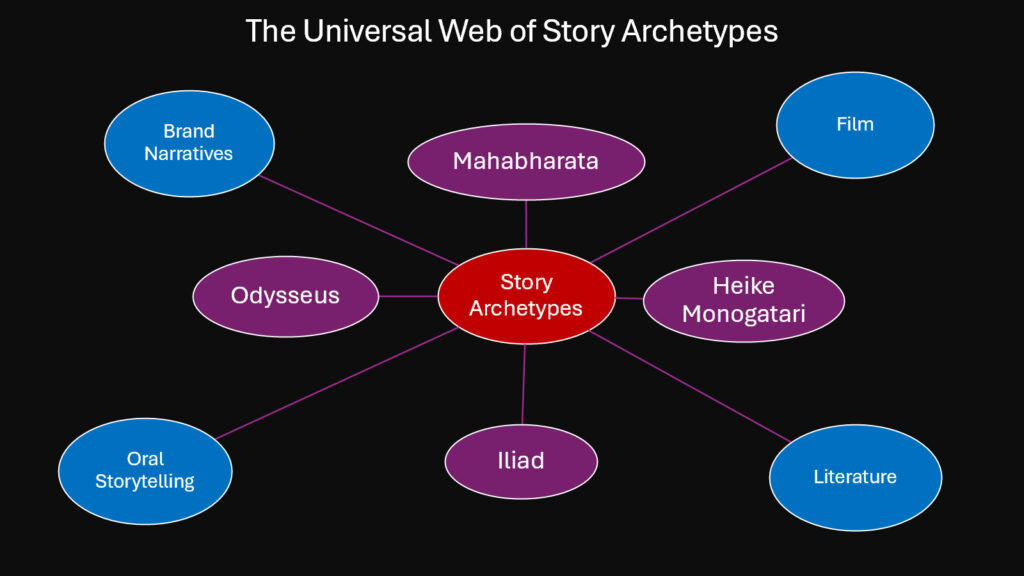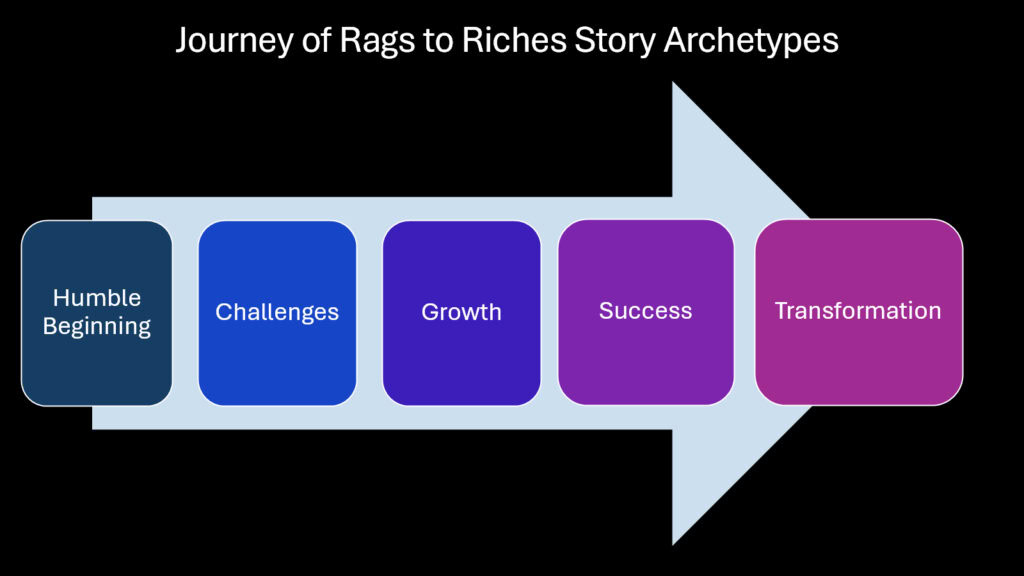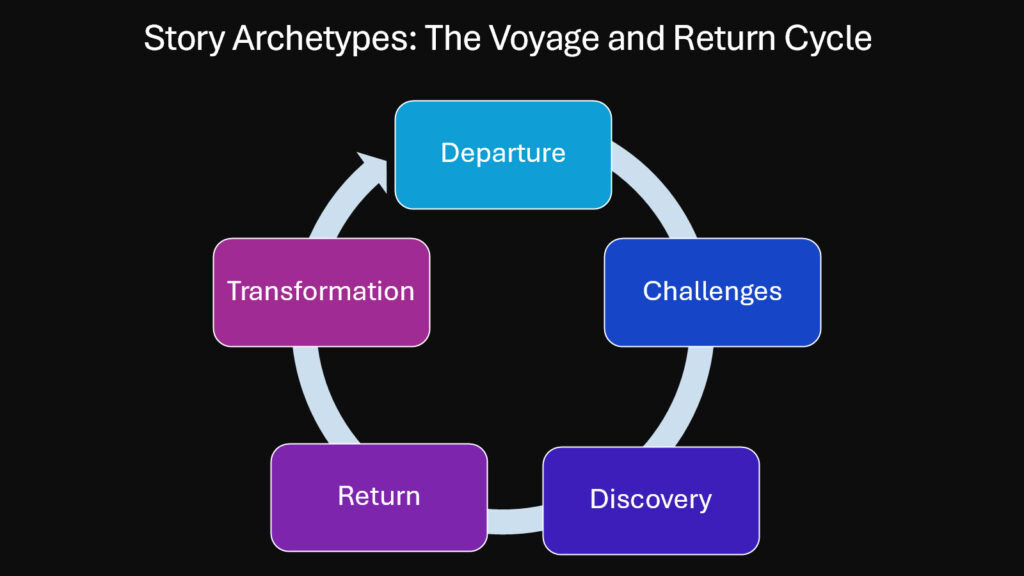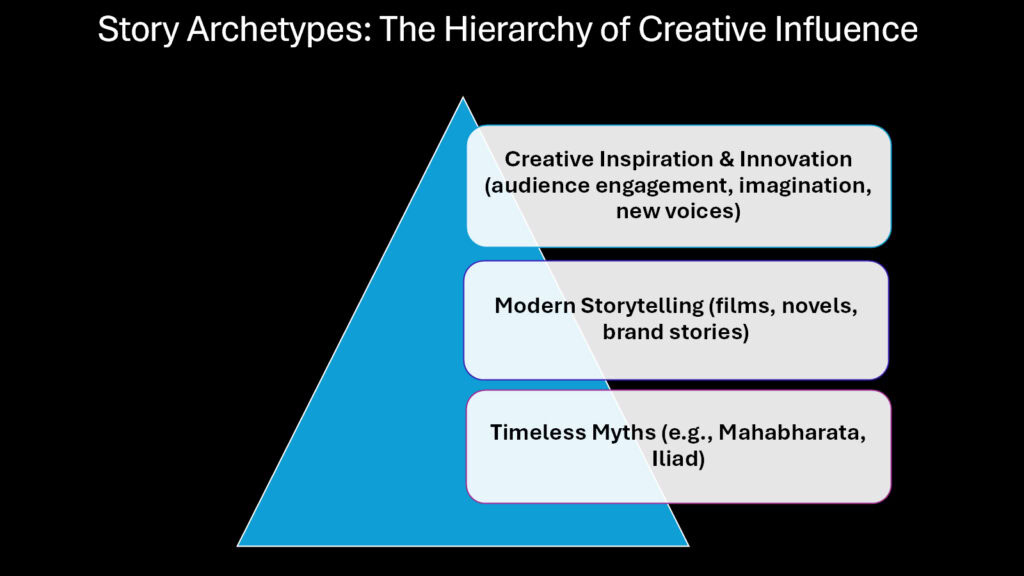Table of Contents
Introduction: The Timeless Power of Story Archetypes in Creative Expression

A young warrior faces a dragon in firelight. A beggar discovers royal blood coursing through hidden veins. An artist wanders strange lands seeking something nameless and returns forever changed. These moments feel familiar because they are. Story archetypes are the invisible architecture behind all great narratives, the blueprints that shape human imagination across every culture and century.
From the battlefields of the Mahabharata, where Arjuna confronts moral chaos, to the wine-dark seas of the Odyssey, where Odysseus wages his ten-year journey home, to the tragic samurai honor in the Heike Monogatari, to the wrath and pride colliding in the Iliad—these ancient texts reveal patterns that transcend their origins. They speak a language older than words, one written in the collective dreams of humanity.
This article explores six story archetypes that continue to spark creative thinking in writing, film, and brand storytelling. These patterns are not formulas to trap imagination but companions to guide it. They bridge myth and modern creativity, connecting the campfire tales of ancestors with the streaming series of today.
Carl Jung believed archetypes spring from the collective unconscious, that deep reservoir of human experience shared across all minds. Northrop Frye expanded this view, arguing that literature itself revolves around archetypal patterns that repeat because they capture fundamental truths about existence. When creators tap into story archetypes, they access this wellspring, drawing from waters that have nourished storytellers for millennia. Understanding these patterns does not limit originality. It amplifies it.
Story Archetypes Across World Literature and Mythology
| Epic/Text | Cultural Origin | Core Archetypal Pattern |
|---|---|---|
| Mahabharata | Ancient India | Quest and moral conflict |
| The Iliad | Ancient Greece | Overcoming enemies and fate |
| The Odyssey | Ancient Greece | Voyage and return home |
| Heike Monogatari | Medieval Japan | Tragic fall and honor |
| Beowulf | Anglo-Saxon England | Monster slaying and heroism |
| Ramayana | Ancient India | Quest and righteous triumph |
| The Epic of Gilgamesh | Ancient Mesopotamia | Quest for immortality |
| Popol Vuh | Maya civilization | Creation and divine struggle |
1. Story Archetypes of Triumph: Overcoming the Monster
Story Archetypes of Triumph: Classic Monster-Slaying Narratives
| Story | Monster Faced | Cultural Origin |
|---|---|---|
| Beowulf | Grendel and his mother | Anglo-Saxon England |
| Jaws | Great white shark | Modern American cinema |
| Dracula | The undead count | Victorian Gothic literature |
| Perseus myth | Medusa the Gorgon | Ancient Greek mythology |
| Alien | Xenomorph creature | Science fiction cinema |
| Theseus myth | The Minotaur | Ancient Greek mythology |
| Godzilla | Radioactive monster | Japanese cinema |
| Frankenstein | Created monster | Gothic literature |
The monster looms larger than life, its shadow swallowing hope. Yet the hero steps forward anyway. This archetype—defeating overwhelming threats—embodies courage and resilience in their rawest forms. The monster represents more than physical danger. It symbolizes fear itself, the obstacles that seem insurmountable until someone dares to face them.
For writers and artists, this pattern mirrors their own creative battles. The blank page becomes the monster. Self-doubt grows fangs and claws. Every creator knows the terror of confronting work that feels impossible, stories that refuse to cooperate, visions that mock from just beyond reach. Yet the act of creation demands they step into the arena anyway.
Beowulf tears Grendel’s arm from its socket with bare hands, a feat that sounds mythic because it captures something true about human determination. The hero does not overcome through magic or accident but through will and action. Similarly, Steven Spielberg’s Jaws transformed a malfunctioning mechanical shark into cinematic gold by embracing constraint as creative fuel. The monster that wouldn’t work properly forced innovation—showing less, suggesting more, building dread through absence.
This archetype teaches creators that obstacles are not roadblocks but raw material. Fear transforms into creative drive when confronted directly. The act of overcoming becomes the story worth telling. Every innovation in art begins with someone facing a monster others declared unbeatable and discovering that courage itself generates new possibilities.
2. Story Archetypes of Transformation: The Rags to Riches Journey

Transformation stories ignite hope and renewal like nothing else. They promise that circumstances do not define destiny, that hidden potential waits for the right moment to emerge. This archetype portrays inner evolution and creative breakthroughs through the lens of radical change.
Cinderella scrubs floors until magic and determination lift her to the ball. But the true transformation happens inside—the moment she recognizes her own worth despite years of degradation. Charlotte Bronte gave readers Jane Eyre, a plain governess with no fortune or beauty by conventional measures, who refuses to compromise her integrity for security. Jane’s wealth comes not from inheritance but from discovering her voice and claiming her dignity. These stories resonate because they mirror the artist’s journey from obscurity to recognition, from fumbling beginner to confident creator.
Story Archetypes of Transformation: Stages in Classic Narratives
| Stage | Character State | Creative Parallel |
|---|---|---|
| Initial limitation | Oppressed or hidden potential | Early artistic struggle and self-doubt |
| Catalyst moment | Recognition or opportunity | Breakthrough insight or inspiration |
| Earned ascension | New status through growth | Mastery achieved through practice |
| Hidden worth revealed | Dormant talents emerge | Skills develop through dedication |
| Testing period | Challenges threaten progress | Creative obstacles and setbacks |
| Inner transformation | Character gains confidence | Artist finds authentic voice |
| Recognition achieved | Status shifts permanently | Work gains audience and respect |
| Integration | New identity accepted | Creator embraces evolved self |
Modern storytelling continues this tradition. Slumdog Millionaire follows Jamal from Mumbai’s poverty to a game show that could change everything, using memory and resilience as his tools. The transformation archetype works because it acknowledges starting points while insisting they are not ending points. This structure gives creators permission to begin imperfectly and evolve through effort.
The rags to riches pattern is fundamentally optimistic. It suggests that hidden within everyone is something valuable waiting for expression. For artists, this archetype validates the long apprenticeship, the years of work before recognition arrives. It reframes struggle not as failure but as the necessary soil for growth. Every creator begins as Cinderella in the ashes, and every completed work represents their ball gown woven from persistence and vision.
3. Story Archetypes of Discovery: The Quest for Meaning
Story Archetypes of Discovery: Famous Quest Narratives and Their Goals
| Story | Protagonist | Object of Quest |
|---|---|---|
| The Lord of the Rings | Frodo Baggins | Destroy the One Ring |
| Don Quixote | Alonso Quixano | Revive chivalry and meaning |
| The Alchemist | Santiago | Personal legend and treasure |
| The Wizard of Oz | Dorothy Gale | Return home to Kansas |
| Moby Dick | Captain Ahab | Hunt the white whale |
| The Epic of Gilgamesh | Gilgamesh | Discover immortality |
| Heart of Darkness | Marlow | Find Kurtz upriver |
| Into the Wild | Christopher McCandless | Authentic existence in nature |
The quest archetype mirrors the artist’s or writer’s search for inspiration and truth. Every journey—whether across continents or into the self—feeds creative storytelling and personal growth. The hero leaves home seeking something external but discovers internal transformation along the way.
Frodo’s mission to destroy the Ring becomes a meditation on corruption and friendship. Don Quixote tilts at windmills believing them giants, and through his madness reveals how stories shape reality itself. Paulo Coelho’s Santiago crosses deserts learning that treasure lies not in distant pyramids but in understanding home with new eyes. These quests follow a pattern because they capture something essential about human curiosity and development.
Joseph Campbell outlined this pattern in his concept of the monomyth, the hero’s quest that appears across cultures. The hero, clouded with hesitation, is summoned to embark on a quest. Mentors appear offering guidance. Trials test resolve and teach lessons. The hero faces a supreme ordeal, dies symbolically, and is reborn transformed. Finally, the return brings new wisdom back to the community.
This cycle perfectly mirrors the creative process. Artists receive calls to adventure through inspiration or commission. They seek teachers and influences. The work itself becomes a series of trials—failed drafts, rejected pitches, techniques that resist mastery. At some point, every creator faces an ordeal where the work almost defeats them. Pushing through this darkness leads to breakthrough. The completed work represents the return, bringing something new into the world.
The quest archetype drives narrative discovery and imagination by insisting that seeking matters as much as finding. The journey changes the seeker, and that transformation is the real treasure. For creators, this means process matters as much as product. Every artist is a quester, and every blank page is an undiscovered country waiting to be mapped.
4. Story Archetypes of Renewal: Voyage and Return

Stories of leaving, learning, and returning symbolize creative renewal. This archetype fuels narratives about change and rediscovery by depicting characters who venture into strange worlds before coming home transformed. The journey outward mirrors the inward journey of self-exploration.
Homer’s Odyssey epitomizes this pattern. Odysseus spends a decade wandering Mediterranean waters, encountering gods and monsters, losing companions and gaining wisdom. When he finally reaches Ithaca, he returns not as the man who left but as someone forged by experience. The home he finds is both the same place and utterly new because he has new eyes to see it.
Lewis Carroll sent Alice down a rabbit hole into a realm where logic dissolves and imagination reigns. She encounters talking animals, mad tea parties, and cruel queens, each experience stretching her understanding. When she wakes, the real world remains unchanged, but Alice has expanded. Carroll captured how creativity requires venturing beyond normal bounds, playing with impossibility, and returning enriched.
Story Archetypes of Renewal: Voyage and Return Elements
| Element | Function | Example |
|---|---|---|
| Strange world | Challenges assumptions | Wonderland’s absurd logic |
| Transformation | Changes perspective | Dorothy learning about home |
| Return | Applies new wisdom | Odysseus reclaiming his kingdom |
| Entry threshold | Marks departure | Alice falling down rabbit hole |
| Guide figure | Aids navigation | Cheshire Cat offering cryptic advice |
| Tests and trials | Forces growth | Odysseus facing Cyclops and Sirens |
| Recognition | Moment of clarity | Dorothy realizing power within |
| Reintegration | Brings change home | Gulliver struggling with humanity |
This archetype speaks directly to the creative cycle of exploration and reinvention. Artists must regularly leave comfortable territories to discover fresh approaches. A painter might explore new mediums. A novelist might attempt different genres. A filmmaker might study foreign cinema. These voyages into unfamiliar creative spaces risk failure but promise growth.
The return is crucial. Explorers who never come back become lost rather than transformed. Creators must integrate their discoveries, bringing back strange treasures to share with audiences. This cycle of departure and return keeps work fresh, prevents stagnation, and ensures that artists continue evolving rather than repeating themselves endlessly.
5. Story Archetypes of Love: The Power of Connection
Story Archetypes of Love: Types in Narrative Traditions
| Love Type | Core Conflict | Resolution Theme |
|---|---|---|
| Romantic | External barriers to union | Overcoming obstacles together |
| Familial | Loyalty versus independence | Balance and understanding |
| Communal | Individual versus collective | Shared purpose and sacrifice |
| Forbidden | Social rules against connection | Defying convention for truth |
| Redemptive | Love healing brokenness | Transformation through acceptance |
| Tragic | Circumstances preventing union | Loss revealing meaning |
| Platonic | Deep friendship tested | Loyalty transcending hardship |
| Self-love | Internal acceptance struggle | Embracing authentic identity |
Stories built on love—romantic, familial, or communal—reveal humanity’s deepest creative energy. Love generates narrative tension because it makes characters vulnerable. When someone cares deeply, stakes become real. The fear of loss sharpens every choice.
Shakespeare knew this. Romeo and Juliet die because feuding families make love impossible, and their tragedy finally breaks the cycle of hatred. Jane Austen built Pride and Prejudice around the obstacles pride and misunderstanding create between Elizabeth and Darcy, showing how love requires seeing past surfaces to recognize true worth. Modern films like Moonlight explore love as identity, showing how connection shapes who we become.
Reader-Response Theory, developed by critics like Louise Rosenblatt and Wolfgang Iser, suggests that texts only complete themselves through reader engagement. Audiences bring their own experiences and emotions to stories, creating meaning through interaction. This is especially true with love narratives. Each reader connects through their own heartbreaks and hopes, their own understanding of connection and loss.
Love stories become co-creative acts between storyteller and audience. The writer provides the framework, but readers fill it with personal resonance. This explains why romance endures despite countless retellings. Each generation finds themselves in these archetypes, recognizing their own struggles in ancient patterns.
For creators, love archetypes offer emotional resonance with artistic expression. Stories exploring connection tap into universal experiences—the fear of rejection, the joy of being understood, the grief of separation, the triumph of reunion. These emotions fuel creativity because they matter profoundly. Art that explores love accesses the engine of human experience, and audiences respond because these stories reflect their own interior lives.
6. Story Archetypes of Awakening: Rebirth and Revelation
Story Archetypes of Awakening: Rebirth Narratives and Their Catalysts
| Story | Protagonist | Catalyst for Awakening |
|---|---|---|
| A Christmas Carol | Ebenezer Scrooge | Ghostly visitations showing past, present, future |
| The Secret Garden | Mary Lennox | Discovering hidden garden and nurturing life |
| Beauty and the Beast | Beast | Love breaking curse through inner change |
| Groundhog Day | Phil Connors | Reliving same day until learning |
| It’s a Wonderful Life | George Bailey | Angel showing life without him |
| The Fisher King | Parry and Jack | Compassion healing trauma |
| Les Miserables | Jean Valjean | Bishop’s mercy sparking redemption |
| A River Runs Through It | Norman Maclean | Understanding brother through memory |
Rebirth stories serve as metaphors for creative renewal. They show characters trapped by circumstance, habit, or trauma who experience revelation that changes everything. These narratives suggest that transformation remains possible regardless of how fixed or hopeless situations appear.
Charles Dickens crafted the perfect awakening story in A Christmas Carol. Scrooge begins as a miser, emotionally dead and spiritually bankrupt. Through supernatural intervention, he witnesses his past loneliness, present isolation, and future abandonment. These visions crack his hardened heart, and Christmas morning finds him reborn—generous, joyful, connected. Dickens understood that people can change fundamentally when confronted with truth about themselves.
Frances Hodgson Burnett’s The Secret Garden follows Mary from bitter orphan to nurturer of life. The locked garden becomes a metaphor for her own locked heart. As she tends neglected plants, she tends her neglected spirit. The garden’s revival parallels her emotional awakening, showing how caring for something outside ourselves heals interior wounds.
These stories resonate with creators because artistic life involves repeated cycles of death and rebirth. Every creator faces periods of stagnation, times when inspiration dries up and work feels mechanical or impossible. The rebirth archetype offers hope that these fallow periods are not permanent. They are winters before springs, darkness before dawn.
Artists reinvent themselves or their narratives after failure. A novelist whose book gets rejected might discover a new voice through the disappointment. A painter whose style feels exhausted might stumble into fresh territory after struggling. These creative rebirths often require confronting uncomfortable truths—about skill limitations, about market realities, about personal blocks or fears.
The awakening archetype celebrates these transformations. It insists that creative renewal follows examination and acceptance. Just as Scrooge needed ghostly intervention to see clearly, creators sometimes need external feedback or internal crisis to break through stagnation. The moment of revelation—when everything clicks into focus—leads to imaginative rebirth that produces the strongest work.
Conclusion: Why Story Archetypes Continue to Shape Creative Imagination

Story archetypes remain the living pulse of storytelling, linking past myths with modern creativity. They persist not because storytellers lack imagination but because these patterns capture fundamental truths about human experience. Understanding these archetypal structures enhances originality rather than limits it by providing frameworks within which infinite variations can flourish.
The six archetypes explored here—triumph over monsters, transformation from rags to riches, quests for meaning, voyages and returns, love’s power, and rebirth through awakening—continue to inspire new voices, ideas, and perspectives. They work because they mirror how humans actually experience life. We face fears. We transform. We search. We explore and return. We connect. We die and are reborn.
For creators, these archetypes serve as companions rather than formulas. They offer starting points, not destinations. A writer might begin with the quest archetype but discover their story is really about rebirth. A filmmaker might think they are telling a love story and realize it is about overcoming monsters. The patterns are flexible, blending and shifting as creativity demands.
These story archetypes also remind creators that they participate in something larger than individual expression. Every story told joins a conversation that began around prehistoric fires and continues through digital screens. This continuity offers both humility and encouragement. No story is entirely new, but no story is exactly the same either. The story archetypes provide the grammar, but each creator writes their own sentences.
The timeless ability of story archetypes to inspire comes from their roots in the collective unconscious, that shared repository of human experience Jung described. When stories resonate across cultures and centuries, they tap into this deep well. Modern creators who understand these patterns gain access to the same source that fed Homer and the Mahabharata’s composers.
Embrace these story archetypes as creative companions. Let them guide without restricting. Recognize them in the stories you love and the ones you create. They are not cages but wings, not limits but launching points. The monster always waits. The journey always calls. Love always matters. Rebirth always remains possible. These truths fueled the first stories and will fuel the last. Between then and now, they fuel yours.
The Six Story Archetypes and Their Creative Functions
| Archetype | Core Pattern | Creative Application |
|---|---|---|
| Overcoming the Monster | Confronting fear | Facing creative obstacles |
| Rags to Riches | Transformation | Artistic growth and mastery |
| The Quest | Discovery journey | Seeking inspiration and meaning |
| Voyage and Return | Exploration and integration | Creative experimentation |
| Love | Connection | Emotional resonance |
| Rebirth | Renewal | Reinvention after stagnation |




